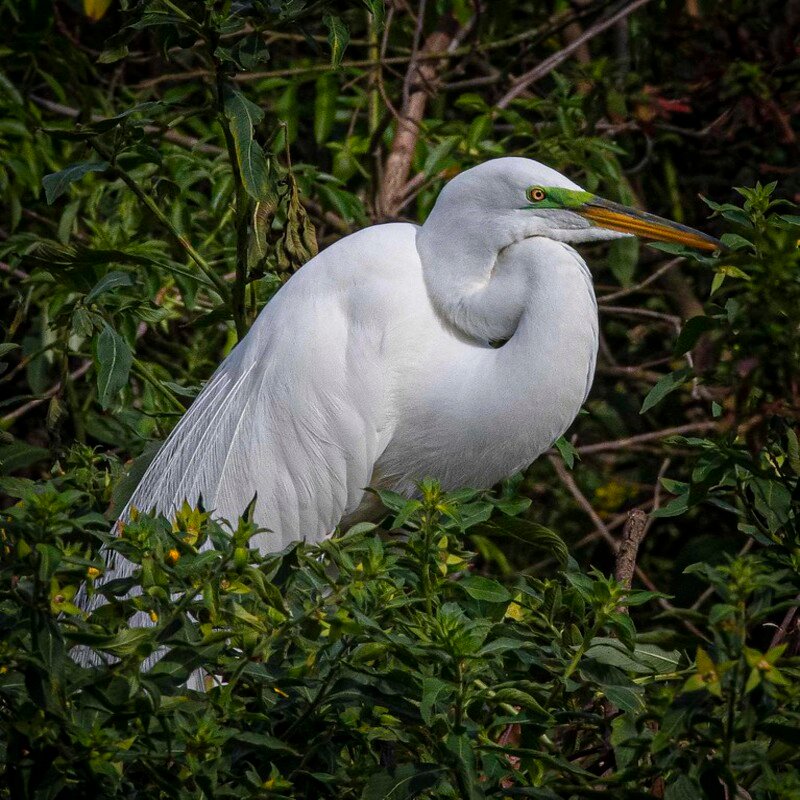The great egret, Ardea alba, also known as the common egret, huge egret, or (in the Old World) great white egret or great white heron, is a large, widely distributed egret found in Asia, Africa, the Americas, and southern Europe. It has four subspecies. It is found in the majority of the world’s tropical and warmer temperate climates, where it makes tree nests in colonies near bodies of water.
Quick Overview: Ardea Alba – Great Egret
Body size: Around 37-41 in (94-104 cm) and a weight of 1699 g (59.96 oz)
Main colors: White, Yellow, Orange, Green, Black
Range: Throughout the United States
Migratory Bird: Yes
Best time of the year to see in the U.S.: March, April, May, September, October, November
Conservation Status: Least Concern
Great Egret Description
This enormous white heron has yellow eyes and a yellow bill with a green lining through its eyes until the bill appears orange during the breeding season. It also has black legs and feet and long feather plumes that stretch from the back to beyond the tail.

Size
These birds have a length of 37-41 in (94-104 cm) and a weight of 1699 g (59.96 oz). Their wings could range from 54-55 in (137-140 cm).
Feeding
The normal food of a great egret includes frogs, snakes, crayfish, fish, mice, crickets, aquatic insects, grasshoppers, and a variety of other insects. Other large wading birds feed similarly to great egrets and compete for food supplies.
Habitat
Great egrets prefer to be near bodies of water. This magnificent bird is found in streams, lakes, ponds, mudflats, saltwater, and freshwater marshes. Great egrets and other heron species love wooded marshes and wetlands.
Behavior
When it comes to courtship, nesting, and feeding, great egrets are quite territorial. They are diurnal feeders and congregate at dusk in nearby locations to establish communal roosts. Dispersal following breeding is extremely prevalent in great egrets. Following hatching, the young join the adults on lengthy trips. Numerous heron species prey on other species in order to increase their food supply. Great egrets steal a disproportionate amount of their food from smaller herons.
Ardea Alba Scientific Classification
- Kingdom: Animalia
- Phylum: Chordata
- Subphylum: Chelicerata
- Class: Aves
- Order: Pelecaniformes
- Family: Ardeidae
- Genus: Ardae
- Species: Ardae alba
Best time of the year to see
In the United States, the best time of year to see these birds are during the Spring season (March-May) and during the Autumn season (September – November).
Distribution of the Great Egret in the USA
Breeds from Washington to western Mexico, and from Manitoba to the Mississippi Valley and the southeast United States; also occurs along the Atlantic coast from northern New England to southern New England. Winters in Oregon, south through the southwest, Texas, and Gulf coast states, and north to Mexico on the Atlantic coast.
The Great Egret can be found in the following states in the United States – Alabama, Alaska, Arizona, Arkansas, California, Colorado, Connecticut, Delaware, Florida, Georgia, Hawaii, Idaho, Illinois, Indiana, Iowa, Kansas, Kentucky, Louisiana, Maine, Maryland, Massachusetts, Michigan, Minnesota, Missouri, Nebraska, Nevada, New Hampshire, New Jersey, New Mexico, New York, North Carolina, North Dakota, Ohio, Oklahoma, Pennsylvania, Rhode Island, South Carolina, South Dakota, Tennessee, Utah, Vermont, Virginia, West Virginia, and Wisconsin.
